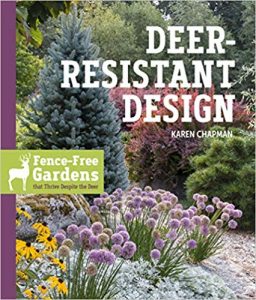 Deer-Resistant Design: Fence-Free Gardens that Thrive Despite the Deer
Deer-Resistant Design: Fence-Free Gardens that Thrive Despite the Deer
The two most asked questions I encounter are “What will grow in dry shade?” and “What won’t the deer eat?” Karen Chapman’s impetus for writing this book was her move to a new home in suburban Seattle where the soil is heavy clay, the winters are wet, and the deer abound. However, each chapter describes gardens in various areas of this country and owners who have different strategies for dealing with deer.
Very important is the knowledge imparted in Karen’s introduction where she discusses strategies and realities. For instance, while mushrooms and acorns are favored foods of deer, they are only available in certain seasons and understory forest plantings may have been browsed so heavily that fawns can’t reach what is left. Deer repellent sprays can be effective but not if you wait too late. Karen advises spraying in late winter to alert the deer that certain plants are not palatable. Then, of course, you will need to respray once the plants foliate and again when the flowers bud. If you are a dog lover, train your dog to do its business on the perimeter of your garden; to the deer, the smell will indicate the presence of a predator.
The trunks of young woody plants need a different type of protection. They need to be wrapped or surrounded with wire caging to prevent deer from rubbing or scraping (pawing the ground and urinating there to deposit olfactory markers.)
Karen mentions two strategies that are fence-like but would not be considered fences by most of us; they are, however, much less expensive than traditional fences. One is the use of lines of fishing wire strung between tree trunks to create an almost invisible fence. They occasionally need to be repaired if the deer breach them. The other is a lattice of rebar that was attached to an existing concrete retaining wall. This is also virtually invisible. If you need an actual fence, one possibility is a five-foot double fence instead of a single eight-foot fence. (See book for photo and explanation.)
When gates cannot be installed across a driveway, one of the homeowner-strategists installed a cattle grid, virtually impossible for deer to walk on.
Karen and many of the other gardeners in her book took note of the routes the deer favored. Some have designed barriers for those areas with plants that are rarely damaged or seldom severely damaged on the Rutgers New Jersey Agricultural Experimental Station rating system. The barrier plants keep deer on their chosen plants and away from other areas with more tasty plants. Others have planted vulnerable perennials such as daylilies on very steep slopes, a tactic that seems to discourage the deer from browsing.
The last chapter of the book is a collection of combinations for containers. Many of the plants chosen could also be used in the ground.
This book is not an encyclopedia of plants that the deer don’t usually eat although the end of each chapter lists each designer’s or homeowner’s top ten plants. The book is much more; it is a selection of well-designed gardens that have dealt with deer issues as well as other animal issues. The discussions of each garden are fascinating because the author clearly outlines the initial design problems and the solutions. The diagrams of each property and the accompanying photographs are extremely helpful.
Chapman, Karen, Deer-Resistant Design: Fence-Free Gardens that Thrive Despite the Deer, Timber Press, Portland, 2019.


0 Comments